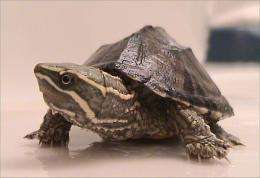May 21, 2010 report
Common musk turtle breathes through its tongue

(PhysOrg.com) -- The North American common musk turtle (Sternotherus odoratus) is a pretty ordinary sort of turtle except for one thing newly discovered by Austrian scientists: it can breathe through its tongue, which allows it to remain underwater for months.
Researchers Egon Heiss and colleagues from the Department of Theoretical Biology at the University of Vienna in Austria, were using high-speed video to study the feeding habits of the musk turtle, a reptile from the eastern U.S. states and in southern Canada, where it lives in freshwater bodies such as lakes and rivers. They discovered the adults spend most of their lives submerged but young turtles sometimes venture on land to look for food. They noticed the turtles can grasp food on land using their jaws but their tongues are clumsy at manipulating food, which is always dropped during the attempt. The only way they can eat the food is to first drag it into the water.
They studied the turtle’s tongue with scanning electron microscopes and light microscopes to find out why, and were surprised to learn the tiny tongue is poorly developed and weak, and is covered in highly vascularized buds or “papillae.” After carrying out further tests the researchers found the tongue plays an important role in gas exchange when the turtle is underwater, drawing in oxygen from the water through the tongue.
Some freshwater turtles must come to the surface to breathe, while others breathe underwater through their skin or using cavities in their rear ends called cloacal bursae. Marine turtles must come to the surface to breathe every few hours. The common musk turtle has until now baffled scientists because it its skin is too thick to breathe through and is poorly supplied with blood, it does not have cloacal bursae, and does not come up for air. Heiss said in a BBC News interview that they “knew that an organ for aquatic respiration must be present somewhere but [we] finally discovered it accidentally.”
The same kind of papillae are also found on the tongues of soft-shelled turtles, but are not found on the European pond turtle (Emys orbicularis), which lives in similar habitats to the musk turtle and does not breathe underwater.
The similarity of the tongues of the musk turtle and soft-shelled turtles suggest the trait may have been present in a shared ancestor of the two groups, and would give the animals an advantage in their aquatic habitat.
The paper was published in the journal The Anatomical Record.
More information: Egon Heiss et al., The Fish in the Turtle: On the Functionality of the Oropharynx in the Common Musk Turtle Sternotherus odoratus (Chelonia, Kinosternidae) Concerning Feeding and Underwater Respiration, The Anatomical Record, 17 May 2010, DOI:10.1002/ar.21185
© 2010 PhysOrg.com

















